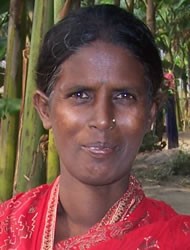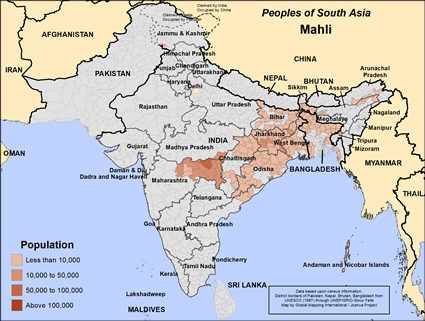Traditions regarding the origin of the Munda-Santal tribes are uncertain; but originally, the forested area of Chotanagpur was ruled by chiefs of various native tribes. Gradually, British authority was established in the plains.
The Munda-Santal of northeastern India and Nepal are comprised of nine different, but very closely related people groups. They are distributed politically throughout the states of Bihar, West Bengal, and Odisha, India. Most of the tribes live in the hilly areas of the Chotanagpur Plateau, located in southern Bihar. Others prefer living in the plains. Beyond this region, they have spread widely throughout India as agricultural and industrial laborers.
The Munda-Santal are divided into clans which recognize a common ancestor. The clans often marry those who are from other tribes; however, there are smaller sub-tribes who are permitted to marry only those within their group. There is also a bachelor's dormitory in all Munda-Santal groups except the Juango.
There are records of a Munda revolt in 1831-1832 and a Santal rebellion of 1855-1858. Of the nine Munda-Santal groups, only the Bhumij have been rulers. For this reason, they claim a higher social status than the others.
The seven groups who occupy territory farther north include the Santal (of India and Nepal), the Bhumij, the Koda, the Mahili, the Ho, and the Agariya. The two remaining groups, the Juango and the Gadaba, are located in the southern portion of India, nearer to the coast of the Bay of Bengal. The native language of the Munda-Santal, called Munda, belongs to the Austro-Asiatic language family. From here we will try to describe the life of the Mahli people.
Most of the Mahli population depends on farming for survival. Some rural families depend on village or cottage industries such as weaving. They supplement their meager agricultural earnings with hunting and gathering.
Tribal culture among the Mahli is quickly changing under the impact of external influences such as industrialization, new communication links, tribal welfare schemes and community development projects.
Today, the Indian government is trying to preserve forests, so cultivation shifting is limited. There is also an increase in the amount of irrigated land. They have developed other sources of income. They include such jobs as working in the tea plantations of the northeast, working in the steel industry, or working as day laborers for local Hindu landowners. Since the Chotanagpur Plateau is the richest mineral belt in India, some of the Mahli earn wages by mining. Both men and women work to bring home adequate income for their families.
The weekly market plays an important part in the economy of the Mahli people. For example, some of them sell their bamboo basketry in local markets.
Mahli settlements are usually located in river valleys; deforested, eroded areas; and mineral and industrial belts. The majority of the people live in clustered villages or villages with one street.
The Mahli have a rich artistic heritage, especially in music and dance. Most tribal villages have a dance floor where worship is offered by a village priest. Though the villages are run by "headmen," the panchayat (religious scholar or monk) is consulted concerning the most important matters. Most conflicts within the tribes concern land rights or marriage.
The Mahli tribe tends to preserve their own beliefs, values and separate identity. In all of the groups, most are Hindus, while the others practice ethnic religions.
In Don Richardson's "Eternity In Their Hearts," we learn about their ancient God called Thakur Jiu, or "Genuine God." They thought that He had forgotten them because they had turned away from Him in fear of the Maran Buru, or "spirits of the great mountains." Their ancestors had made an oath with the Maran Buru when migrating to their present lands. They began to practice spirit appeasement, sorcery and sun worship.
Today, their supreme god is the sun god. However, they have also adopted the Hindu deities in addition to tribal gods and goddesses. The Hindu village priest is the ritual specialist, and they observe many Hindu festivals. They do have a firm belief in an almighty creator and also in "mother earth."
In places where the gospel is being preached to the Munda-Santal, the listeners almost immediately receive after the village council talks it over. These precious tribes are ripe unto harvest; they simply need people to show them the way to the true God!
Ask the Lord to call people who are willing to go to the Mahli people and share Christ.
Pray that the Holy Spirit will soften their hearts towards the gospel.
Ask God to call out prayer teams to break up the soil through worship and intercession.
Ask God to encourage and protect the small number of Hindus who have converted to Christianity.
Pray that God will complete the work begun in the hearts of these believers through adequate discipleship.
Ask the Lord to raise up a triumphant Church among each of the Munda-Santal tribes.
Scripture Prayers for the Mahli in India.
https://en.wikipedia.org/wiki/Mahli
| Profile Source: Joshua Project |











